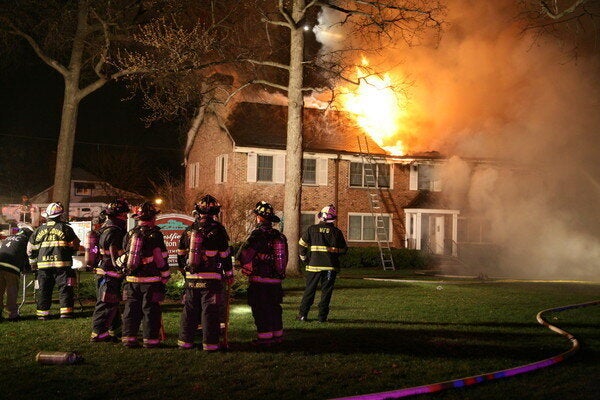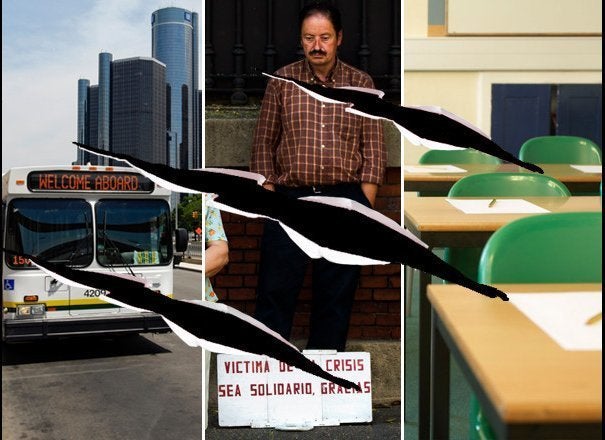
This article is part of a Huffington Post series on the global impact of austerity -- "A Thousand Cuts" -- from affordable housing funds lost in San Francisco to increasing class sizes in New York, food inspector cuts in Canada, disability benefits taken away in the United Kingdom, decimation of France's solar industry, and more. Click here for information on how you can help people affected by these measures.
Shortly before midnight on April 3, 2011, a fire broke out at the Hamilton House complex in Westfield, N.J. It started in the second-floor apartment of Roy Rentrop, 65, a retired Wall Street trader and widower, who had moved to the complex a month earlier.
The cause of the fire has not been determined, but Rentrop told The Huffington Post there was an explosion. His neighbors fled to safety as flames shot out of the roof. The blast knocked him unconscious.
“If one of the firefighters had not kicked in the door, we wouldn’t be having this conversation right now,” Rentrop said.
He was airlifted by helicopter to a nearby hospital, where doctors placed him in a medically induced coma and treated him for smoke inhalation. He remained in the hospital for six weeks.
The blaze was so fierce that firefighters from 12 towns worked until 4 a.m. to extinguish it. But a key piece of equipment, the Westfield Fire Department's ladder truck, sat in the firehouse because there were not enough Westfield firefighters on duty to operate it. Instead, the volunteer fire department in nearby Mountainside, a 3-to-5-minute drive from Hamilton House, had to send its ladder truck to the scene.
Westfield firefighters union president Mike Sawicki told HuffPost that the department has been hampered by a 25-percent reduction in firefighters over the past two years, with town officials choosing not to fill eight jobs vacated by retirement and two through off-duty deaths. The town has also cut a deputy chief and the fire prevention official, who handled fire safety education, Sawicki said. He noted the department now runs on four seven-man shifts instead of four nine-man shifts.
The National Fire Protection Association recommends that four firefighters be on duty for each piece of apparatus sent out, be it an engine or a ladder truck, according to Ken Willette, manager of the group's public fire protection division. The association also recommends that towns have a system in place that can get 15 firefighters to a fire scene within 12 minutes.
“Instead of operating using industry best practices, the Westfield Fire Department has been relying on luck for far too long,” James Ryan Jr., vice president of the local firefighters union, told town officials on April 23, 2011.
“They are asking you to do more with less," Sawicki said. "A second-grader can figure that out. Show up with nine guys, and it is easier to save.”
While the number of deadly fires has declined over the last 20 years nationwide, thanks to better construction and safety techniques, fire departments are increasingly called upon to answer medical emergencies, chemical spills and more, said Garry Biese, CEO for the International Association of Fire Chiefs.
Yet fire departments are going short-handed. The precipitous drop in state and local revenues caused by the Great Recession, combined with budget cuts pushed by austerity-minded politicians, has led to static or slowly dropping staffing levels across the country. Budget troubles have beset fire departments from Minneapolis to Irving, Texas, Detroit, New London, Conn., Hialeah, Fla., and Kansas City, Mo. Proposed firefighter cuts in Chambersburg, Pa., were only stopped after the community was awarded a federal grant.
In Los Angeles, the fire department's budget for the 2011-2012 year was $472 million, down from $561 million two years before. Last year the city council voted to leave 318 firefighting positions unfilled. It now takes first responders an average 12 extra seconds to respond to medical emergencies, according to a city audit.
__________________________________________________________________________________
HuffPost readers: Has funding been cut for firefighters near you? Email offthebus@huffingtonpost.com, and include a phone number if you're willing to be interviewed.__________________________________________________________________________________
"The trend is that fire departments are under serious financial pressure, like many other departments of city government, to reduce their costs," Biese said.
"Go to any of these cities that are shutting these companies down. The math is very simple," agreed Harold Schaitberger, president of the International Association of Fire Fighters.
With the cuts, firefighters who were previously coming to the scene as secondary support are now expected to be the first ones to the rescue, Schaitberger said. "Take a company out of service that is supposed to be providing four-minute response times, and now you have the second-due company that's now supposed to be providing first-due service."
Fortunately for some communities (including Chambersburg), federal Staffing for Adequate Fire and Emergency Response (SAFER) grants have doled out $1.9 billion to states and localities to retain firefighters even in the midst of the downturn. The International Association of Fire Fighters estimates that the program has saved 13,000 jobs.
As Schaitberger noted, firefighters have "a very positive image, which certainly has the ability to translate politically." Congress appropriated $640 million for the grants in 2011 and 2012, up from $630 million in 2009 and 2010.
In June, however, presumptive Republican presidential nominee Mitt Romney said that he believed the country should not be spending federal dollars on local firefighters, police officers and teachers. Romney has not indicated how the SAFER grants would fare if he were elected.
Even with federal help, however, states and cities still have to cover workers' pension costs. And that can be a sticking point.
In Ohio last year, Gov. John Kasich (R) attempted to strip all public workers of their right to collective bargaining in order to cut costs -- including pensions -- for local governments. The fight gained national attention, and Ohio voters rejected the move overwhelmingly. But firefighters in Taylor, Mich., may not be so lucky.
Although Taylor received an $8 million SAFER grant to save 32 firefighters' jobs, Mayor Jeff Lamarand doesn't want to pay $1 million in pension benefits to keep them. Lamarand survived a 2011 recall attempt, launched in part because of his cuts to fire and police jobs.
"They're doing it because they're just trying to simply strong-arm us [the unions] into long-term concessions," Schaitberger contended of communities that have refused SAFER funding or declined to even apply.
Even volunteer firefighters, who are already saving states money on salaries and pensions, have been hurt by cuts. In Texas, budget cuts pushed through by Gov. Rick Perry (R) forced volunteer firefighters, who were battling raging wildfires in 2011, to buy their own gear and even gas for the fire trucks.
In Westfield, the fire department cuts are part of a series of austerity measures the town has implemented in recent years. Twenty-five percent of the public workforce has been eliminated, including the town hall custodial staff and the director of human services, according Councilman Dave Haas (D). The cuts were necessitated by years of declining revenue, primarily from taxes and various fees, along with decreases in state aid. In March 2010, Gov. Chris Christie (R) slashed state aid across New Jersey, reducing Westfield’s share by $941,000.
Sawicki, the local union president, said the fire department's inability to use its ladder truck has been an issue in multiple fires.
A month after the Hamilton House fire, a six-alarm blaze destroyed Ferraro’s, an Italian restaurant that occupied a stucco building in downtown Westfield, along with several apartments above it and a nearby clothing store. Two people were treated for smoke inhalation.
Sixteen fire companies battled the Ferraro’s fire throughout the night, with nearby Cranford, N.J., dispatching the first ladder truck, which arrived 12 minutes after Westfield firefighters did. Ferraro's is located just 100 yards from the town's main firehouse, where its ladder truck sat all night.
After the flames had been extinguished, residents gathered across the street to mourn the local landmark, which opened in 1969. It is hard to say what difference those 12 minutes made, Sawicki said, but he believes they had an impact.
“You got to think about it, if we pulled the ladder truck out and flowed 1,100 gallons of water a minute,” Sawicki said.
Westfield Mayor Andy Skibitsky (R) disagreed.
“We had over 100 firefighters at Ferraro’s,” Skibitsky said, noting all the help the town received from its neighbors.
Towns sharing firefighting resources is common, but it doesn't always work out well. Earlier this year, only six firefighters were on duty in Westfield when a house fire erupted on Barchester Way. And three of them were away providing aid to neighboring Springfield.
The three remaining Westfield firefighters could battle the fire only from the outside because of the state’s “two in, two out” rule, which states that two firefighters must remain outside for every two who enter a burning building. The only exception is to save a life. Extinguishing a fire can take longer if firefighters can't enter a building and attack the blaze directly.
On May 23, just days after the Barchester fire, Ellen DiIorio told Westfield council members about another fire that destroyed her house. She and her husband had to be rescued from their second-floor bedroom. She said that Westfield firefighters waited 15 minutes for Plainfield, N.J., firefighters to arrive before they could help.
"If we had had children across the hall or an elderly parent who was bedridden, we would not have been able to rescue them, and they could have possibly lost their lives because the Westfield Fire Department, their hands were tied, and they could not enter the building," DiIorio told council members.
"I'm here to plead with you that we could have enough firefighters in Westfield to avoid a possible loss of human life," she said. "I love the town of Westfield, and I loved my home, and I can never go home again."
According to Westfield Councilman Keith Loughlin (R), vice chairman of the public safety committee, it costs the city $100,000 a year to hire a new firefighter, once training is factored in.
The city has applied for a SAFER grant, which officials hope to hear about in the fall. Under the terms of the grant, the town would be able to hire four more firefighters for at least two years.
Still, Loughlin insisted the cuts aren't a problem
“I don’t consider us to have a manpower shortage,” he said. “We are adequately staffed."
